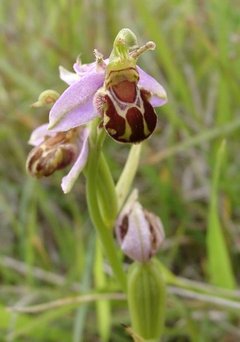Bee Orchid
|
|
| Bee orchid | ||||||||||||||||||
|---|---|---|---|---|---|---|---|---|---|---|---|---|---|---|---|---|---|---|
 Bee Orchid | ||||||||||||||||||
| Scientific classification | ||||||||||||||||||
|
The Bee Orchid (Ophrys apifera) is a rare and protected perennial, growing on semi-dry turf, on limestone, calcareous dunes or in open areas in woodland. They are very unusual. Some years they appear in great numbers, then sometimes only reappear after a decade.
The Bee Orchid occurs all across Europe to the Levant. This hardy orchid grows to a height of 30 cm. They live in a symbiotic relationship with a soil-dwelling fungus.
The Bee Orchid develops small rosettes of leaves in autumn. They slowly continue to grow during winter. Flowers appear the following year. Each year, it produces from one to ten flowers on a spike, blooming from June to July. The Bee orchid is rarely visited by insects, the flowers are self-pollinating. The petals are marginal and spread out, colored mauve to pink. The flower is furry to the touch and is quite variable in the pattern of coloration, but usually brownish-red with yellow markings.
The alternate leaves are elliptical and pointed.
Ophrys_apifera_plant.jpg
Ophrys_apifera_flower2.jpg
